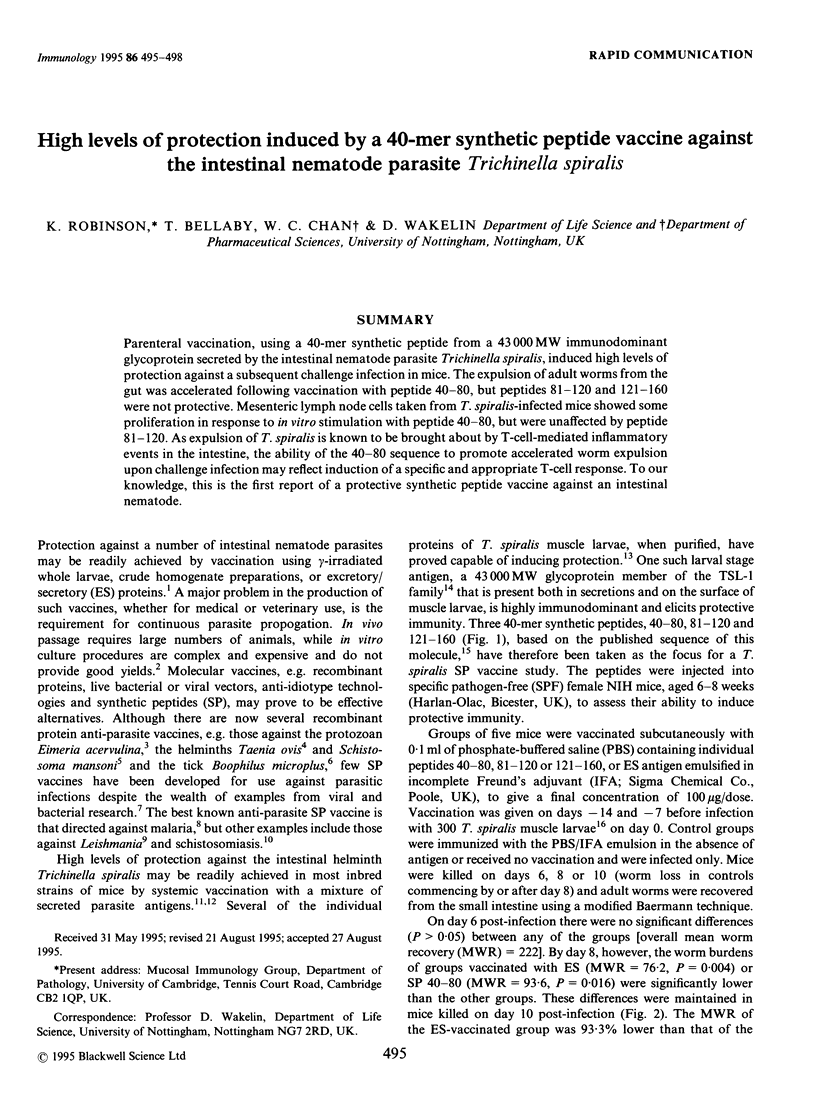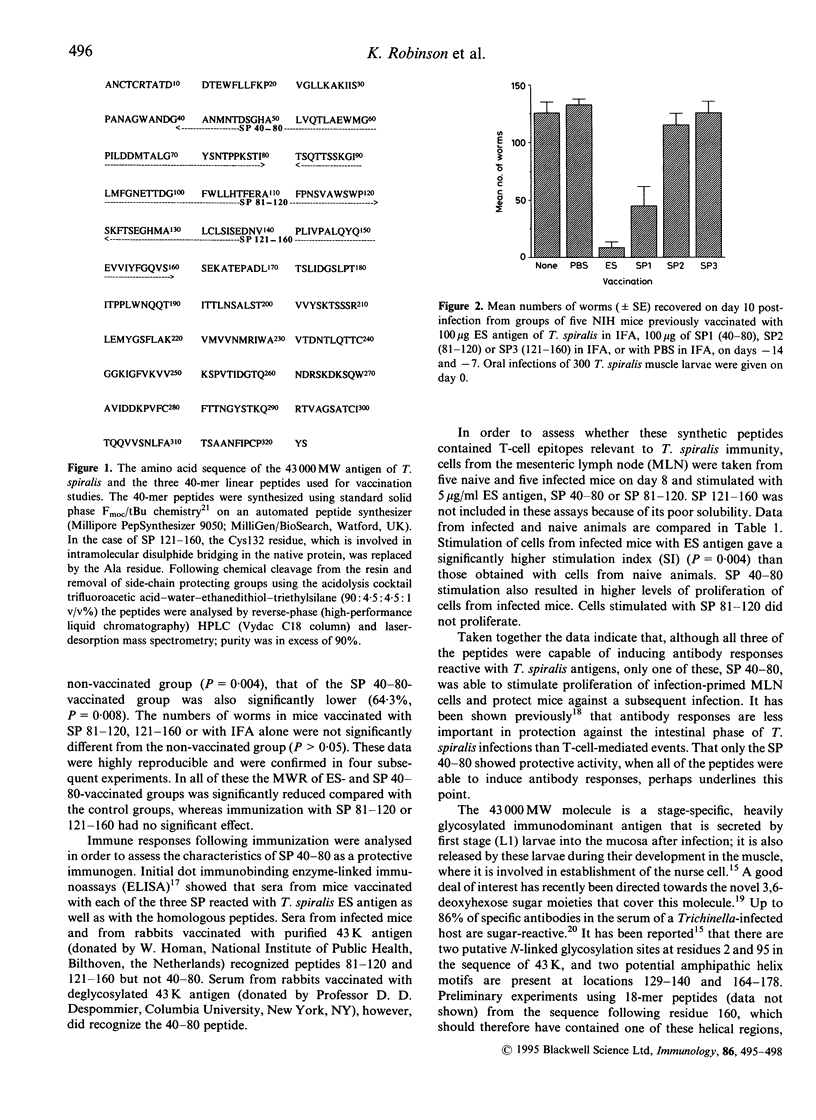Abstract
Parenteral vaccination, using a 40-mer synthetic peptide from a 43,000 MW immunodominant glycoprotein secreted by the intestinal nematode parasite Trichinella spiralis, induced high levels of protection against a subsequent challenge infection in mice. The expulsion of adult worms from the gut was accelerated following vaccination with peptide 40-80, but peptides 81-120 and 121-160 were not protective. Mesenteric lymph node cells taken from T. spiralis-infected mice showed some proliferation in response to in vitro stimulation with peptide 40-80, but were unaffected by peptide 81-120. As expulsion of T. spiralis is known to be brought about by T-cell-mediated inflammatory events in the intestine, the ability of the 40-80 sequence to promote accelerated worm expulsion upon challenge infection may reflect induction of a specific and appropriate T-cell response. To our knowledge, this is the first report of a protective synthetic peptide vaccine against an intestinal nematode.
Full text
PDF



Selected References
These references are in PubMed. This may not be the complete list of references from this article.
- Balloul J. M., Sondermeyer P., Dreyer D., Capron M., Grzych J. M., Pierce R. J., Carvallo D., Lecocq J. P., Capron A. Molecular cloning of a protective antigen of schistosomes. Nature. 1987 Mar 12;326(6109):149–153. doi: 10.1038/326149a0. [DOI] [PubMed] [Google Scholar]
- Emery D. L., McClure S. J., Wagland B. M. Production of vaccines against gastrointestinal nematodes of livestock. Immunol Cell Biol. 1993 Oct;71(Pt 5):463–472. doi: 10.1038/icb.1993.52. [DOI] [PubMed] [Google Scholar]
- Jenkins M. C., Castle M. D., Danforth H. D. Protective immunization against the intestinal parasite Eimeria acervulina with recombinant coccidial antigen. Poult Sci. 1991 Mar;70(3):539–547. doi: 10.3382/ps.0700539. [DOI] [PubMed] [Google Scholar]
- Johnson K. S., Harrison G. B., Lightowlers M. W., O'Hoy K. L., Cougle W. G., Dempster R. P., Lawrence S. B., Vinton J. G., Heath D. D., Rickard M. D. Vaccination against ovine cysticercosis using a defined recombinant antigen. Nature. 1989 Apr 13;338(6216):585–587. doi: 10.1038/338585a0. [DOI] [PubMed] [Google Scholar]
- Patarroyo M. E., Romero P., Torres M. L., Clavijo P., Moreno A., Martínez A., Rodríguez R., Guzman F., Cabezas E. Induction of protective immunity against experimental infection with malaria using synthetic peptides. Nature. 1987 Aug 13;328(6131):629–632. doi: 10.1038/328629a0. [DOI] [PubMed] [Google Scholar]
- Reynolds S. R., Dahl C. E., Harn D. A. T and B epitope determination and analysis of multiple antigenic peptides for the Schistosoma mansoni experimental vaccine triose-phosphate isomerase. J Immunol. 1994 Jan 1;152(1):193–200. [PubMed] [Google Scholar]
- Robinson K., Bellaby T., Wakelin D. Immune response profiles in vaccinated and non-vaccinated high- and low-responder mice during infection with the intestinal nematode Trichinella spiralis. Parasitology. 1995 Jan;110(Pt 1):71–78. doi: 10.1017/s0031182000081063. [DOI] [PubMed] [Google Scholar]
- Robinson K., Bellaby T., Wakelin D. Vaccination against the nematode Trichinella spiralis in high- and low-responder mice. Effects of different adjuvants upon protective immunity and immune responsiveness. Immunology. 1994 Jun;82(2):261–267. [PMC free article] [PubMed] [Google Scholar]
- Silberstein D. S., Despommier D. D. Antigens from trichinella spiralis that induce a protective response in the mouse. J Immunol. 1984 Feb;132(2):898–904. [PubMed] [Google Scholar]
- Towbin H., Gordon J. Immunoblotting and dot immunobinding--current status and outlook. J Immunol Methods. 1984 Sep 4;72(2):313–340. doi: 10.1016/0022-1759(84)90001-2. [DOI] [PubMed] [Google Scholar]
- Vassilatis D. K., Despommier D., Misek D. E., Polvere R. I., Gold A. M., Van der Ploeg L. H. Analysis of a 43-kDa glycoprotein from the intracellular parasitic nematode Trichinella spiralis. J Biol Chem. 1992 Sep 15;267(26):18459–18465. [PubMed] [Google Scholar]
- Wakelin D., Lloyd M. Immunity to primary and challenge infections of Trichinella spiralis in mice: a re-examination of conventional parameters. Parasitology. 1976 Apr;72(2):173–182. doi: 10.1017/s0031182000048472. [DOI] [PubMed] [Google Scholar]
- Wakelin D., Mitchell L. A., Donachie A. M., Grencis R. K. Genetic control of immunity to Trichinella spiralis in mice. Response of rapid- and slow-responder strains to immunization with parasite antigens. Parasite Immunol. 1986 Mar;8(2):159–170. doi: 10.1111/j.1365-3024.1986.tb00842.x. [DOI] [PubMed] [Google Scholar]
- Willadsen P., Bird P., Cobon G. S., Hungerford J. Commercialisation of a recombinant vaccine against Boophilus microplus. Parasitology. 1995;110 (Suppl):S43–S50. doi: 10.1017/s0031182000001487. [DOI] [PubMed] [Google Scholar]
- Yang D. M., Rogers M. V., Liew F. Y. Identification and characterization of host-protective T-cell epitopes of a major surface glycoprotein (gp63) from Leishmania major. Immunology. 1991 Jan;72(1):3–9. [PMC free article] [PubMed] [Google Scholar]


